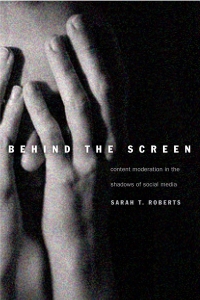In Behind the Screen: Content Moderation in the Shadows of Social Media, Sarah T. Roberts explores the work conditions and experiences of people employed in ‘commercial content moderation’, drawing on interviews with those tasked with detecting and removing harmful and upsetting online content. As the problems faced by CCM workers reveal the economic, social and political distortions of the digital age, this book will be of interest to social science researchers as well as anyone who is a user of social media, writes H. Guney Akgul.
Behind the Screen: Content Moderation in the Shadows of Social Media. Sarah T. Roberts. Yale University Press. 2019.
 Find this book (affiliate link):
Find this book (affiliate link): ![]()
Today, we encounter fake news, terrorism, child exploitation, cyberbullying and racism on social media more easily and swifter than offline, although there are global workforces and algorithms that are designed to detect and remove such content as soon as possible. After reading Behind the Screen: Content Moderation in the Shadows of Social Media by Sarah T. Roberts, we can only imagine the path of social media if there were no such workforce or gatekeepers.
In her book, Roberts introduces a new term for this hidden workforce: ‘commercial content moderation’ (CCM). More than 100,000 people are employed as CCM workers, yet they are anonymous on social media. Roberts focuses on understanding how this work shapes their professional and private lives and tries to find answers to a number of questions over eight years of fieldwork: ‘Who were they? Where did they work and under what conditions? What was their work life like? What decisions were they being charged with?’ (23). But, according to Roberts, the most critical question was: ‘why were we not collectively talking about them, about the work they did and its impact on them and on the internet so many of us consume and where so many of us spend our lives?’ (24). Her search for answers to these questions brings a new explosive contribution to the literature.
The overall content of Behind the Screen is based on extensive fieldwork through one-on-one interviews with CCM workers who have spread around the world to places including Silicon Valley, rural Iowa, Canada, Mexico, the Philippines and India. In Chapter Two, Roberts sets out her theoretical framework and creates a ‘taxonomy of the locations and conditions that are typical for most content moderation workers’ (40). Roberts details four basic types of work situation for professional moderators: in house; boutiques; call centres; and microlabour websites, as shown in Table 1 (41-43). Each type is evaluated based on three points:
- Worksite location (From where they can work?)
- Employment characteristics (What is their task? What kind of company do they work for?)
- Employment Status (Contract and salary information)
Roberts proceeds to include interviewees to represent the whole spectrum of these different types of work situation.
Behind the Screen discovers the low-wage and low-status nature of CCM work as well as its psychological pressures (71). In so doing, Roberts critiques earlier theorists’ expectations concerning post-industrial labour in the twenty-first century, Manuel Castells being an important figure among these. These theorists anticipated that workers could find jobs with greater flexibility, mobility and higher status, and would have even more leisure time in the Information Age. However, as Roberts later mentions with reference to David Harvey’s explanation of the nature of neoliberalism, these changes have been ‘of benefit almost solely to employers and corporate interests’ (196). Above all, through later interviews with CCM workers in the Philippines, the author reveals the existence of a flow reminiscent of the formal colonial form as Western companies benefit from the cheap labour market in Asia and have privileged rights. East Asian countries have created ‘special industrial zones’ or ‘special economic zones’ for Western industries, meaning that companies can now easily access ‘globalized knowledge work’, rooted in tax exemptions as well as cheap, low-status and contractual labour (60-67).
Image Credit: Photo by Philipp Katzenberger on Unsplash
As a result of Roberts’s interviews, it is clear that no one has consciously been trained to work on commercial content moderation: they chose this kind of work because they did not know about the content of the job and had no better offers. Interviews with workers in Silicon Valley, who were working for ‘MegaTech’ (the pseudonym for a major multinational internet giant), reveal that they are generally well-educated, new graduates. They were still vague on the details of CCM work, even after job interviews (77). Since ‘MegaTech is a major global distribution platform for people attempting to draw attention to all sorts of causes, including political crisis, conflicts, and war crimes’ (98), CCM workers encounter countless upsetting material as they watch videos to ensure they do not contain violence, porn, harassment or hate speech. Max Breen, who was working for Megatech, shares his experience in the book. During the Arab Spring, he had to work with extensive violent content; decisions about whether or not this can be displayed are usually related to current US foreign policy (99). The relationship between this and Silicon Valley, long discussed in the media, is revealed in this section of the book.
Paradoxically, although companies look for well-educated employees for CCM, the job itself is mainly based on ‘a click’, hence it has become routinised. Josh Santos, who works for MegaTech, mentions that ‘it is factory work, almost. It is doing the same thing over and over.’ With this routine, workers not only feel insignificant in society but also disconnected from other people. As Santos puts it: ‘you kind of feel like you spent eight hours just in this hole of filth that you don’t really want to talk about it’ (118). Even relationships with their partners were negatively affected. Breen claims: ‘Horror movies are ineffective at this point. I have seen all that stuff in real life’ (122). Their private and social lives become damaged; they do not have fully subsidised health insurance to protect their mental health; and they are working under low salaries and short contract periods.
The book makes a convincing proposition as to why social media companies like Google, Facebook and ‘MegaTech’ create bad working conditions for CCM workers: this is an inherited problem under neoliberalism that cannot be separated from historical dynamics of capital and labour relations. The other problem that Roberts considers is why people are creating this kind of content, and why we need such gatekeepers. As we know from events such as the Arab Spring, social media has been accepted as constituting a new public sphere, especially focused on revealing and organising social movements. But the levels of fake news circulating in social media have also played an important role in the ‘unexpected political triumph of [Donald] Trump’ and the ‘Brexit campaign’ (204), raising doubts about the democratic status of social media.
Roberts talks to Melinda Graham about her CCM experience at YouNews between 2007 and 2008 (156). She confirms that one can’t really win discussions on social media. If you warn users not to make insulting comments, it is very easy to get extremely threatening messages in return. Another problematic aspect: upper management warned her that ‘we don’t want people to think we are censoring them’ (159). With this kind of policy, the domination of people who make such comments on social media is expanding day by day. As a result, CCM workers cannot share their identities on social media. As Graham states:
I am queer, I am femme, I am an atheist, I’m pretty much a working-class identified woman, I am married [to another woman], I am pretty much what these people hate. That’s my identity and […] that was not necessarily a prudent identity to make public when you are trying to do a moderation job (162).
Yet, algorithms or filters cannot stop such users. They easily find a way to work around them. The book reveals the problematic structure of social media through these experiences.
In Chapter Five, Roberts reflects on the effects of former colonial relations on today’s digital labour, including historical legacies of ‘military, economic and cultural dominance’ (183). Metro Manila is one of the metropolitan areas and special economic zones of the Philippines and contains seventeen cities or municipalities. These kinds of special ‘ecozones’ have been urbanised partly based on the needs of global companies, ‘such as uninterrupted electricity, the capacity for large scale bandwidth for data transfer, and so on’ (183). Metro Manila has countless ‘business process outsourcing’ centres or call centres (172). Eastwood City, where Roberts interviews five CCM workers, is one such centre. Besides answering calls, these workers are responsible for combining profiles for a dating app that has millions of users all over the world. Drake Pineda, one of these young workers, reveals how they compete over time: ‘we have a quota, it’s like 150 [tickets] per hour’ (178). Another worker, Sofia de Lenon, states that it was previously 100. In the interviews, one of the reasons for this increase is seen as a cheaper service in India. They used to work with 105 colleagues before; now there are only 24 people. In their words, social media platforms are establishing their own colonies of exploitation in such ecozones where workers’ rights cannot develop.
Behind the Screen, the result of Roberts’s years of research, gives us insight into a period when social media is no longer novel. Roberts provides a thorough study of those employed in CCM, highlighting the dark sides of social media, and clearly demonstrating the economic, social and political distortions of the digital age through the problems faced by CCM workers. This book will be of interest to social science researchers as well as anyone who is a social media user.
Note: This review gives the views of the author, and not the position of the LSE Review of Books blog, or of the London School of Economics. The LSE RB blog may receive a small commission if you choose to make a purchase through the above Amazon affiliate link. This is entirely independent of the coverage of the book on LSE Review of Books.









1 Comments